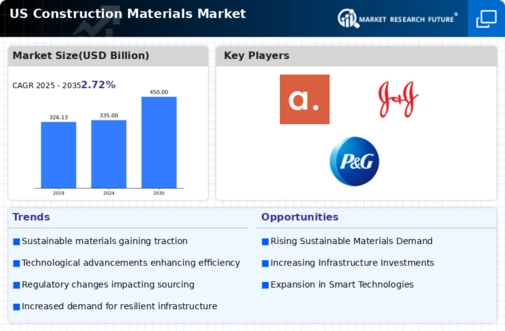The construction materials market in the US is characterized by a competitive landscape that is increasingly shaped by innovation, sustainability, and strategic partnerships. Key players such as LafargeHolcim (Switzerland), Martin Marietta Materials (US), and CRH (Ireland) are actively pursuing strategies that emphasize technological advancements and operational efficiencies. LafargeHolcim (Switzerland) has focused on enhancing its product portfolio through sustainable practices, while Martin Marietta Materials (US) has concentrated on expanding its regional footprint and optimizing its supply chain. CRH (Ireland) appears to be leveraging digital transformation to streamline operations, which collectively influences the competitive dynamics by fostering a more agile and responsive market environment.
In terms of business tactics, companies are increasingly localizing manufacturing to reduce transportation costs and enhance supply chain resilience. The market structure is moderately fragmented, with a mix of large multinational corporations and smaller regional players. This fragmentation allows for a diverse range of offerings, yet the collective influence of major players like LafargeHolcim (Switzerland) and Martin Marietta Materials (US) is significant, as they set benchmarks for quality and innovation that smaller firms often strive to meet.
In November 2025, LafargeHolcim (Switzerland) announced a partnership with a leading technology firm to develop AI-driven solutions for optimizing concrete production. This strategic move is likely to enhance operational efficiency and reduce waste, aligning with the growing emphasis on sustainability within the industry. The integration of AI technologies could potentially revolutionize production processes, making them more adaptable to fluctuating market demands.
In October 2025, Martin Marietta Materials (US) completed the acquisition of a regional aggregates company, which is expected to bolster its market share in the southeastern US. This acquisition not only expands its operational capacity but also enhances its ability to serve a growing customer base in a region experiencing increased construction activity. Such strategic acquisitions are indicative of a trend where companies seek to consolidate their positions in key markets to drive growth.
In September 2025, CRH (Ireland) launched a new line of eco-friendly building materials aimed at reducing carbon emissions during construction. This initiative reflects a broader industry trend towards sustainability, as companies recognize the importance of environmentally responsible practices in attracting customers and complying with regulatory standards. By prioritizing sustainable product offerings, CRH (Ireland) positions itself as a leader in the evolving market landscape.
As of December 2025, the competitive trends in the construction materials market are increasingly defined by digitalization, sustainability, and the integration of advanced technologies. Strategic alliances are becoming more prevalent, as companies recognize the need to collaborate in order to innovate and meet the demands of a rapidly changing market. Looking ahead, competitive differentiation is likely to shift from traditional price-based competition to a focus on innovation, technology integration, and supply chain reliability, as firms strive to meet the evolving expectations of customers and regulatory bodies.














Leave a Comment